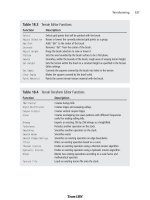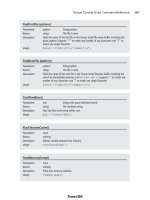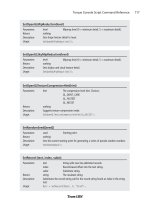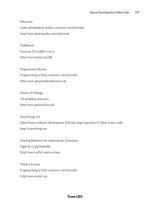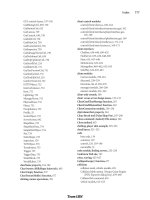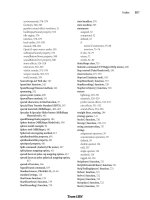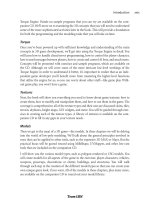Game Programming All in One 2 nd Edition phần 10 ppsx
Bạn đang xem bản rút gọn của tài liệu. Xem và tải ngay bản đầy đủ của tài liệu tại đây (945.74 KB, 83 trang )
6. Which function is used to initialize the mouse handler?
A.
install_mouse
7. Which values or functions are used to read the mouse position?
A.
mouse_x
and
mouse_y
8. Which function is used to read the mouse x and y mickeys for relative motion?
D.
get_mouse_mickeys
9. What is the name of the main
JOYSTICK_INFO
array?
B.
joy
10. Which struct contains joystick button data?
C.
JOYSTICK_BUTTON_INFO
Chapter 6
1. What is the best way to get started creating a new game?
D. Play other games to engender some inspiration.
2. What types of games are full of creativity and interesting technology that PC
gamers often fail to notice?
A. Console games
3. What phrase best describes the additional features and extras in a game?
C. Bells and whistles
4. What is usually the most complicated core component of a game, also called the
graphics renderer?
D. The game engine
5. What is the name of an initial demonstration of a game that presents the basic
gameplay elements before the actual game has been completed?
B. Prototype
6. What is the name of the document that contains the blueprints for a game?
C. Design document
7. What are the two types of game designs presented in this chapter?
A. Mini and complete
Chapter 6 637
8. What does NPC stand for?
D. Non-Player Character
9. What are the chances of a newcomer finding a job as a full-time game program-
mer or designer?
D. Negligible
10. What is the most important aspect of game development?
A. Design
Chapter 7
1. What does “blit” stand for?
B. Bit-block transfer
2. What is a DHD?
C. Dial home device
3. How many pixels are there in an 800×600 screen?
A. 480,000
4. What is the name of the object used to hold a bitmap in memory?
D.
BITMAP
5. Allegorically speaking, why is it important to destroy bitmaps after you’re done
using them?
C. Because the trash will pile up over time.
6. Which Allegro function has the potential to create a black hole if used improperly?
A.
acquire_bitmap
7. What types of graphics files are supported by Allegro?
B. BMP, PCX, LBM, and TGA
8. What function is used to draw a scaled bitmap?
B.
stretch_blit
9. Why would you want to lock the screen while drawing on it?
A. If it’s not locked, Allegro will lock and unlock the screen for every draw.
10. What is the name of the game you’ve been developing in this book?
D. Tank War
Appendix A
■
Chapter Quiz Answers638
Chapter 8
1. What is the term given to a small image that is moved around on the screen?
B. Sprite
2. Which function draws a sprite?
A.
draw_sprite
3. What is the term for drawing all but a certain color of pixel from one bitmap to
another?
C. Transparency
4. Which function draws a scaled sprite?
A.
stretch_sprite
5. Which function draws a vertically-flipped sprite?
B.
draw_sprite_v_flip
6. Which function draws a rotated sprite?
D.
rotate_sprite
7. Which function draws a sprite with both rotation and scaling?
B.
rotate_scaled_sprite
8. What function draws a pivoted sprite?
C.
pivot_sprite
9. Which function draws a pivoted sprite with scaling and vertical flip?
A.
pivot_scaled_sprite_v_flip
10. Which function draws a sprite with translucency (alpha blending)?
B.
draw_trans_sprite
Chapter 9
1. Which function draws a standard sprite?
C.
draw_sprite
2. What is a frame in the context of sprite animation?
A. A single image in the animation sequence
Chapter 9 639
3. What is the purpose of a sprite handler?
A. To provide a consistent way to animate and manipulate many sprites on the
screen
4. What is a struct element?
D. A variable in a structure
5. Which term describes a single frame of an animation sequence stored in
an image file?
B. Tile
6. Which Allegro function is used frequently to erase a sprite?
A.
rectfill
7. Which term describes a reusable activity for a sprite that is important in a game?
D. Behavior
8. Which function converts a normal sprite into a run-length encoded sprite?
B.
get_rle_sprite
9. Which function draws a compiled sprite to a destination bitmap?
C.
draw_compiled_sprite
10. What is the easiest (and most efficient) way to detect sprite collisions?
A. Bounding rectangle intersection
Chapter 10
1. Does Allegro provide support for background scrolling?
A. Yes, but the functionality is obsolete.
2. What does a scroll window show?
A. A small part of a larger game world
3. Which of the programs in this chapter demonstrated bitmap scrolling for
the first time?
C. ScrollScreen
4. Why should a scrolling background be designed?
D. To achieve the goals of the game
Appendix A
■
Chapter Quiz Answers640
5. Which process uses an array of images to construct the background as it is displayed?
C. Tiling
6. What is the best way to create a tile map of the game world?
A. By using a map editor
7. What type of object comprises a typical tile map?
C. Numbers
8. What was the size of the virtual background in the GameWorld program?
A. 800×800
9. How many virtual backgrounds are used in the new version of Tank War?
B. 1
10. How many scrolling windows are used in the new Tank War?
C. 2
Chapter 11
1. Why is it important to use a timer in a game?
A. To maintain a consistent frame rate
2. Which Allegro timer function slows down the program using a callback function?
D.
rest_callback
3. What is the name of the function used to initialize the Allegro timer?
B.
install_timer
4. What is the name of the function that creates a new interrupt handler?
D.
install_int
5. What variable declaration keyword should be used with interrupt variables?
C.
volatile
6. What is a process that runs within the memory space of a single program but is
executed separately from that program?
C. Thread
7. What helps protect data by locking it inside a single thread, preventing that data
from being used by another thread until it is unlocked?
A. Mutex
Chapter 11 641
8. What does pthread stand for?
C. Posix Thread
9. What is the name of the function used to create a new thread?
B.
pthread_create
10. What is the name of the function that locks a mutex?
D.
pthread_mutex_lock
Chapter 12
1. What is the home site for Mappy?
C.
2. What kind of information is stored in a map file?
A. Data that represent the tiles comprising a game world
3. What name is given to the graphic images that make up a Mappy level?
D. Tiles
4. What is the default extension of a Mappy file?
C. FMP
5. Where does Mappy store the saved tile images?
B. Inside the map file
6. What is one example of a retail game that uses Mappy levels?
B. Hyperspace Delivery Boy
7. What is the recommended format for an exported Mappy level?
D. Text map data
8. Which macro in Mappy fills a map with a specified tile?
A. Solid Rectangle
9. How much does a licensed copy of Mappy cost?
D. It’s free!
10. Which MappyAL library function loads a Mappy file?
A.
MapLoad
Appendix A
■
Chapter Quiz Answers642
Chapter 13
1. In which game genre does the vertical shooter belong?
A. Shoot-em-up
2. What is the name of the support library used as the vertical scroller engine?
C. MappyAL
3. What are the virtual pixel dimensions of the levels in Warbirds Pacifica?
D. 640×48,000
4. What is the name of the level-editing program used to create the first level of
Warbirds Pacifica?
B. Mappy
5. How many tiles comprise a level in Warbirds Pacifica?
A. 30,000
6. Which of the following games is a vertical scrolling shooter?
B. Mars Matrix
7. Who created the artwork featured in this chapter?
C. Ari Feldman
8. Which MappyAL function loads a map file?
B.
MapLoad
9. Which MappyAL function removes a map from memory?
D.
MapFreeMem
10. Which classic arcade game inspired Warbirds Pacifica?
C. 1942
Chapter 14
1. Which term is often used to describe a horizontal-scrolling game with a walking
character?
B. Platform
2. What is the name of the map-editing tool you have used in the last several chapters?
A. Mappy
Chapter 14 643
3. What is the identifier for the Mappy block property representing the background?
A. BG1
4. What is the identifier for the Mappy block property representing the first
foreground layer?
A. FG1
5. Which dialog box allows the editing of tile properties in Mappy?
D. Block Properties
6. Which menu item brings up the Range Alter Block Properties dialog box?
B. Range Edit Blocks
7. What is the name of the MappyAL struct that contains information about tile
blocks?
C.
BLKSTR
8. What MappyAL function returns a pointer to a block specified by the (x,y)
parameters?
A.
MapGetBlock
9. What is the name of the function that draws the map’s background?
A.
MapDrawBG
10. Which MappyAL block struct member was used to detect collisions in the
sample program?
C.
tl
Chapter 15
1. What is the name of the function that initializes the Allegro sound system?
A.
install_sound
2. Which function can you use to play a sound effect in your own games?
C.
play_sample
3. What is the name of the function that specifically loads a RIFF WAV file?
B.
load_wav
4. Which function can be used to change the frequency, volume, panning, and
looping properties of a sample?
D.
adjust_sample
Appendix A
■
Chapter Quiz Answers644
5. What function would you use to shut down the Allegro sound system?
B.
remove_sound
6. Which function provides the ability to change the overall volume of sound output?
A.
set_volume
7. What is the name of the function used to stop playback of a sample?
D.
stop_sample
8. Within what range must a panning value remain?
D. 0 to 255
9. What parameter should you pass to
install_sound
to initialize the standard digital
sound driver?
C.
DIGI_AUTODETECT
10. What is the name of the function that plays a sample through the sound mixer?
B.
play_sample
Chapter 16
1. What is the shorthand term for an Allegro data file?
B. datafile
2. What compression algorithm does Allegro use for compressed datafiles?
A. LZSS
3. What is the command-line program that is used to manage Allegro datafiles?
D. dat.exe
4. What is the Allegro datafile object struct called?
B.
DATAFILE
5. What function is used to load a datafile into memory?
D.
load_datafile
6. What is the data type format shortcut string for bitmap files?
C.
BMP
7. What is the data type constant for wave files, defined by Allegro for use in reading
datafiles?
C.
DAT_SAMPLE
Chapter 16 645
8. What is the
dat
option to specify the type of file being added to the datafile?
A.
-t <type>
9. What is the
dat
option to specify the color depth of a bitmap file being added to
the datafile?
C.
-bpp <depth>
10. What function loads an individual object from a datafile?
D.
load_datafile_object
Chapter 17
1. Which company developed the FLI/FLC file format?
A. Autodesk
2. Which product first used the FLI format?
C. Animator
3. Which product premiered the more advanced FLC format?
A. Animator Pro
4. What is the common acronym used to describe both FLI and FLC files?
D. FLIC
5. Which function plays an FLIC file directly?
A.
play_fli
6. How many FLIC files can be played back at a time by Allegro?
A. 1
7. Which function loads an FLIC file for low-level playback?
C.
open_fli
8. Which function moves the animation to the next frame in an FLIC file?
A.
next_fli_frame
9. What is the name of the variable used to set the timing of FLIC playback?
D.
fli_timer
10. What is the name of the variable that contains the bitmap of the current
FLIC frame?
B.
fli_bitmap
Appendix A
■
Chapter Quiz Answers646
Chapter 18
1. Which of the following is not one of the three deterministic algorithms covered in
this chapter?
C. Conditions
2. Can fuzzy matrices be used without multiplying the input memberships? Why or
why not?
A. No, it is absolutely necessary to multiply the input memberships.
3. Which type of system solves problems that are usually solved by specialized
humans?
A. Expert system
4. Which type of intelligence system is based on an expert system, but is capable of
determining fractions of complete answers?
B. Fuzzy logic
5. Which type of intelligence system uses a method of computing solutions for a
hereditary logic problem?
C. Genetic algorithm
6. Which type of intelligence system solves problems by imitating the workings
of a brain?
D. Neural network
7. Which of the following uses predetermined behaviors of objects in relation
to the universe problem?
B. Deterministic algorithm
8. Which type of deterministic algorithm “fakes” intelligence?
C. Random motion
9. Which type of deterministic algorithm will cause one object to follow another?
A. Tracking
10. Which type of deterministic algorithm follows preset templates?
D. Patterns
Chapter 18 647
Chapter 19
1. What is the study of angles and their relationships to shapes and various other
geometries?
D. Trigonometry
2. What is the name of the C function that calculates cosine?
B.
cos
3. What is the name of the C function that calculates sine?
A.
sin
4. What is the name of the C function that calculates tangent?
A.
tan
5. Which C function calculates the inverse sine?
D.
asin
6. Which C function calculates the inverse tangent?
C.
atan
7. What does a set intersection contain?
C. The elements that are contained in both sets
8. What does a function differentiation return?
A. The slope of the function at any given position
9. What is the opposite of function differentiation?
C. Integration
10. What Greek letter is most often used in calculations of degrees or radians of a circle?
C. Pi
Chapter 20
1. What is the first step you must take before attempting to get your game published?
A. Evaluate the game.
2. What is the most important question to consider in a game before seeking a
publisher?
C. Is it graphically attractive?
Appendix A
■
Chapter Quiz Answers648
3. What is the second most important aspect of a game?
B. Sound
4. What is an important factor of gameplay, in the sense of a beginning, middle,
and ending, that must be considered?
D. Continuity
5. What adjective best describes a best-selling game?
D. Addictive
6. What is an NDA?
C. Non-Disclosure Agreement
7. What is a software bug?
A. An error in the source code
8. What term describes a significant date in the development process?
B. Milestone
9. Who created the game Smugglers 2?
A. Niels Bauer
10. For whom should you create a game for the purpose of entertainment?
A. Yourself
Chapter 20 649
This page intentionally left blank
651
Useful Tables
Appendix B
T
his appendix includes an ASCII table and three mathematical tables containing
integral equations, derivative equations, and inertia equations.
Integral Equations Table
Derivative Equations Table
Inertia Equations Table
Appendix B
■
Useful Tables652
Char Value Char Value Char Value
ASCII Table
This is a standard ASCII chart of character codes 0 to 255. To use an ASCII code, simply
hold down the ALT key and type the value next to the character in the table to insert the
character. This method works in most text editors; however, some editors are not capable
of displaying the special ASCII characters (codes 0 to 31).
ASCII Table 653
Appendix B
■
Useful Tables654
Char Value Char Value Char Value
ASCII Table 655
Char Value Char Value Char Value
This page intentionally left blank
657
Numbering Systems:
Binary and Hexadecimal
Appendix C
T
here are three numbering systems commonly used in computer programming—
binary, decimal, and hexadecimal. The binary numbering system is called Base-2
because it has only two digits: 0 and 1.The decimal system is called Base-10; it is the
one with which you are most familiar because it is used in everyday life. The hexadecimal
system is called Base-16 and is comprised of the numerals 0–9 and the letters A–F to
represent values from 0–15. Computers use the binary system exclusively in the hardware,
but to make programming easier, compilers support decimal and hexadecimal (and the
little-used Octal numbering system—Base-8).
Binary
Binary numbers use the Base-2 system, in which the numbers are represented by digits of
either 0 or 1. This is the system the computer uses to store all the data in memory. Each digit
in the number represents a power of two. Table C.1 shows the values in the binary system.
The best way to read a binary number is right to left; the first digit is to the far right and
the last digit is to the far left. The number 1101, read from right to left, has the order 1, 0,
Table C.1 Binary System
Position Digit
10
21
Appendix C
■
Numbering Systems: Binary and Hexadecimal658
1, 1. The position of each digit determines the value of that digit, and each position is
twice as large as the previous (with the first digit representing 0 or 1). Table C.2 provides
a breakdown.
Table C.2 Binary Values Table
Position Value
11
22
34
48
516
632
764
8 128
9 256
10 512
11 1,024
12 2,048
13 4,096
14 8,192
15 16,384
16 32,768
17 65,536
18 131,072
19 262,144
20 524,288
21 1,048,576
22 2,097,152
23 4,194,304
24 8,388,608
25 16,777,216
26 33,554,432
27 67,108,864
28 134,217,728
29 268,435,456
30 536,870,912
31 1,073,741,824
32 2,147,483,648
Using this table you can decode any binary number as long as you remember to read the
number from right to left and add up each value. How about an example?
The number 10101110 can be decoded as:
0 * 1 = 0
1 * 2 = 2
1 * 4 = 4
1 * 8 = 8
0 * 16 = 0
1 * 32 = 32
0 * 64 = 0
1 * 128 = 128
Adding up the values 2 + 4 + 8 + 32 + 128 = 174. Anyone can read a binary number in
this way, as long as it is read from right to left. With a little practice you will be convert-
ing binary numbers in your head in only a few seconds.
Decimal
You have probably been using the decimal system since childhood and you don’t even
think about counting numbers in specific digits because you have been practicing for so
long. The Base-10 numbering system is a very natural way for humans to count because
we have 10 fingers. But from a scientific point of view, it’s possible to decode a decimal
number by adding up its digits, as you do for binary.
For example, try to decode the number 247. What makes this number “two hundred forty
seven?” The decimal system has 10 digits (thus the name decimal) that go from 0–9. Just
as with the binary system, you decode the number from right to left (although it is read
from left to right in normal use). Because each digit in 247 represents a value to the power
of 10, you can decode it as:
7 * 1 = 7
4 * 10 = 40
2 * 100 = 200
Adding up the values 7 + 40 + 200 = 247. Now this is asinine for the average person, but
for a programmer, this is a good example for understanding the other numbering systems
and it is a good lesson.
Hexadecimal
The hexadecimal system is a Base-16 numbering system that uses the numbers 0–9 and
the letters A–F (to represent the numbers 10–15, since each position must be represented
Hexadecimal 659
Appendix C
■
Numbering Systems: Binary and Hexadecimal660
by a single digit). Decoding a hexadecimal number works exactly the same as it does for
binary and decimal—from right to left, by adding up the values of each digit. For refer-
ence, Table C.3 provides a breakdown of the values in the hexadecimal system.
To read a hexadecimal number (in other words, to convert it to decimal so a human can
understand it), just decode the hexadecimal digits from right to left using the table of values
and multiply each digit by a successive power of 16. It was easy to calculate Base-2
multipliers, but it is a little more difficult with hexadecimal. Since hex numbers increase
quickly in value, there are usually very few digits in a hex number—just look at the huge
number after only 10 digits! Table C.4 shows multipliers for Base-16.
Using this newfound information, you should be able to decode any hex number. For
instance, the hex number 9C56D is decoded like this:
D: 1 * 13 = 13
6: 16 * 6 = 96
5: 256 * 5 = 1,280
C: 4,096 * 12 = 49,152
9: 65,536 * 9 = 589,824
Table C.3 Hexadecimal Table
Value Digit
00
11
22
33
44
55
66
77
88
99
10 A
11 B
12 C
13 D
14 E
15 F
Adding these values results in 13 + 96 + 1,280 + 49,152 + 589,824 = 640,365. Because
these numbers grow so quickly in Base-16, they are usually grouped in twos and fours
when humans need to read them. Any hex number beyond four digits is usually too much
for the average programmer to calculate in his head. However, the small size of a hex num-
ber usually means it cuts out several digits from a decimal number, which makes for more
efficient storage in a file system. For this reason, hex numbers are used in compression and
cryptography.
Hexidecimal 661
Table C.4 Hexadecimal Table
Position Multiplier
01
1 16 (16^1)
2 16 (16^2)
3 256 (16^3)
4 4096 (16^4)
5 65,536 (16^5)
6 1,048,576 (16^6)
7 16,777,216 (16^7)
8 268,435,456 (16^8)
9 4,294,967,296 (16^9)
10 68,719,476,736 (16^10)
